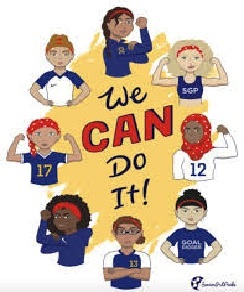We’re living in a global pandemic. You might be feeling scared, anxious, or stressed. I’ve felt those feelings too during the past few weeks. After some meditation, a virtual conference with my therapist, and a subjectively adequate number of grape Airheads (don’t ask me how many), I gathered myself. I took a nap, drank my water, ate my vegetables, and got my thoughts together. Here is what I came up with.
You are not alone in feeling fear, anxiety, or isolation.
A poll shows that more than half of Americans report being anxious about the possibility that they, their friends or loved ones might become infected. Truthfully, it would be a bit alarming if there was a worldwide pandemic and we didn’t feel some type of way about it, and that’s okay.
We are all in this pandemic together, but not in the same ways.
This pandemic is a threat to our normal. Yet, this doesn’t mean the same to everyone. While a commonality among us is that we’re in this pandemic together, it’s important to acknowledge not all groups of people are experiencing it exactly like you. Some people are sheltering in place in a safe, comfortable home that has running water and lightning fast Wi-Fi. Others don’t have these luxuries now, nor have they ever. Their transition to this “new normal” is more complex.
Communities are using services available to them to best serve their diverse K-12 and postsecondary-level students. Unfortunately, many of these services are only available to individuals who fit the narrow stereotype of a U.S. citizen. If you are racially/ethnically minoritized or part of a marginalized community, there is less help for you. In order to get through this, the demographically diverse U.S. will have to realize that, as Americans, we do not all fit the same mold. We are experiencing this pandemic in different ways, and the support that is afforded to us must reflect that reality.
What can we do NOW?
The Center for Disease Control (CDC) recommends maintaining a distance of at least 6 feet between people and avoiding large groups. This sounds to me like physical distancing. Although the CDC acknowledges that we sometimes refer to this as physical distancing, the term “social distancing” is more common. Unfortunately, it fundamentally misconstrues the plan of action. Its misinterpretation leads to much panic since it is so tied to social connectedness, which is one of our most basic human needs. We should not be threatening our sense of social connectedness by engaging in social distancing. Instead, we should reframe our new normal as practicing physical distancing.
Social connectedness is also referred to as social belongingness. Humans have a need to belong and must feel like they are cared for by the group they want to (or should) fit into. When our sense of belonging is threatened or has been taken, we immediately work toward restoring it. Thus, when we were told to maintain social distancing, many educators panicked. If we can’t physically interact with our students, how will we teach them and maintain their motivation? How will we sustain work productivity among colleagues?
Well, first we should start by strengthening our collective sense of belonging.
Educators must show students, teachers, and communities they matter.
It more important than ever to demonstrate how much we need each other. We must cultivate a strong sense of belonging in educational settings to move on to higher-order needs like academic performance. The educational system should explicitly acknowledge that all students, including those from minoritized or marginalized communities, exist, are valued, respected, and cared for in this new educational context.
Beautiful things happen when you take the time to help people feel like they belong. Appreciating an individual and taking an active role in strengthening their sense of belonging gets positive outcomes. Unfortunately, institutional responses to COVID-19 have not done a great job of fostering a sense of belonging among students. Many minoritized and marginalized students who already felt a low sense of belonging in educational contexts feel even less cared for as a result of non-inclusive responses during COVID-19.
We can fix this!
Certain communities already know what to do. Hence, it’s time to consult with them. Dr. José M. Causadias recently said it best via Twitter:
A lot of us are highlighting how COVID-19 is disproportionally affecting people of color. This is crucial, but we ALSO need to document how POC use their rich cultural capital to cope, resist, and even thrive during this crisis #AcademicTwitter #COVID19
— José M. Causadias, PhD (@JoseCausadias) April 4, 2020
Not many have experienced a global pandemic, but minoritized and marginalized communities have definitely been through traumatic experiences. Experiencing historical trauma, racism-related stress, and chronic discrimination have led these communities to develop coping strategies that allow them to thrive during times of adversity. We must not only support these communities but also work with them to spread knowledge of already existing culturally relevant solutions.
Individuals within these amazingly resilient communities are already engaging in practices that promote belongingness. Dr. Helen Neville tweeted about utilizing #RadicalHope to combat negative effects of COVID-19, saying:
"Radical hope helps me draw on the strength of my ancestors to get through this particular moment knowing that we have been through some really difficult times in our history."
#RadicalHopeRising ✨
— Helen Neville (@HelenNeville12) April 2, 2020
Radical #hope in these difficult times means ...
Join us & share! Brought to you by the Psychology of Radical Healing Collective: @HelenNeville12 @NYChavez @DellaVMosley @GACspeaksout @HYAdames @JioniLewis @DoctorBry pic.twitter.com/V75tD16HWS
I’ll close by spreading some belongingness love: This world, this country, this community would not be the same without you. I see you and I value you. You matter and we need you. Take a nap. Drink your water. Eat your vegetables. Once you’re ready, let’s do this. We’re going to get through this together.
